![]()
![]()
![]()
Use LEFT and RIGHT arrow keys to navigate between flashcards;
Use UP and DOWN arrow keys to flip the card;
H to show hint;
A reads text to speech;
31 Cards in this Set
- Front
- Back
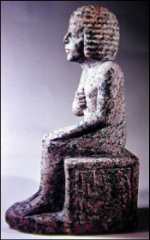
|
Metjen Statue, Dynasty 4, Saqqara. First false door, table scene, detailed hieroglyphics of biographical text, daily life scenes. First private tomb - vizier. Found by Lepsius |
|
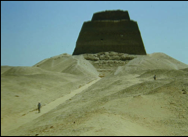
|
Snefru's pyramid, Maidum, D4, Limestone. First real pyramid complex - prototype for other pyramid complexes. Valley and causeway temples. secondary pyramid. Only one of Snefru's pyramids built in Maidum. The others were built in Dashur. |
|
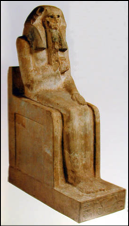
|
King Djoser Statue. Dynasty 3. Limestone. Statue in heb seb outfit - festival for 30 year old kings to prove their worth. Statue in the serdab - ceremonial tomb with small hole so the smell of offerings could reach the deceased. first king living exclusively in Memphis - new center of culture. |
|
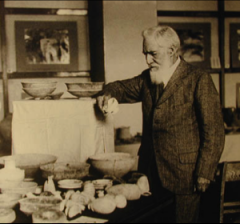
|
Flinders Petrie Location - Abydos, Armana and Giza - 1882 Made Predynastic era discoveries. Catalogued Naqada I pots using sequence dating: wavey handled -> smaller waves -> drawings of waves. Did a relative scale of 30-80 years in case some turned up before and after. Wavey handles originated in Mesopotomai |
|
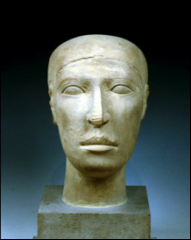
|
Reserve Heads, Giza Private Tomb, Dynasty 4. extremely realistic. Found in burial tombs, either a bad statue or in case the buried owner lost their head in the after life. Represent individuals, Shaved nose as distinctive feature. |
|
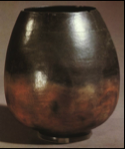
|
Badarian black top clay pots. Predynastic. Nile Clay, turns black when exposed to sun. Only functional, not yet decorative. People still organised in small goups. |
|
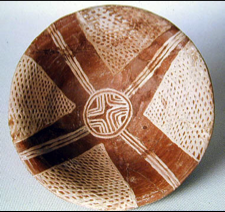
|
White Cross Lined / White Cross Long Ware El Amra, Naqada I - Amration. Major pottery development, new pottery style. First efforts to decorate. Nile Silt covered in red hematite. Beginnings of expansion of Naqada culture. Bowl curved in specific way |
|
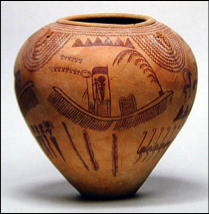
|
Red Buff on Ceramic - Gerza - Naqada II. Marl Clay - difficult to work with but produces a sturdy product. Detailed Depiction of Boats and Kings. Authority of the Nile Boat. Shows egyptian wide contact with other areas, trade, hierarchal society, specialisation - ceramic makers therefore organisation. No longer hunting and gathering. Elites want luxury items. Gerzean pottery begins to expand to other areas. |
|

|
Gebel El Arak Knife Handle in the Louvre. Upper Egypt, Naqada III, Hippo Ivory Hippo, smiting scene. Decorated Weapon. Shows master of animals, defeating chaos and mastery over humans. Figures in mesopotamian outfits, shows conflict, man v man, boats below show conflict with other countries |
|
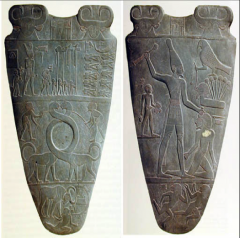
|
Narmer Palette. Naqada III/Dynasty 0 Greywacke Very well preserved, palettes are decorative and symbolic. Represents unification of Upper and Lower Egypt - crown of both kingdoms shown on the Palette. Symbols of the King: Horus Falcon, crook in his hand, smiting, royal beard, crown. Using art as a political tool. First real King of Egypt. Register lines split up scenes. Detailed - feathers, muscles or ruler. Intertwining necks from Mesopotamia. Victorious Bull. |
|
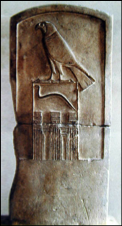
|
King Djet's Stela & Serekh- Abydos, Dynasty 1/2 Stela - tombstone slab. Serekh - early version of Cartouche. King's name in hieroglyph contained within a palace facade with a Horus Falcon looking over. Enscription of name promised eternal life. Used in front of doors: became tradition for years. Only way to identify tomb. |
|
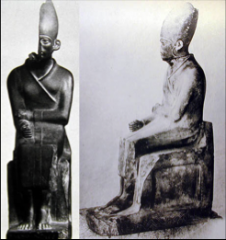
|
*not on image list* Statues of Khasekhemwy Fortress Hierakonpolis, Dynasty 2, Limestone First king to make statues of himself. Inscriptions at bottom show battle scenes and accomplishments. |
|

|
Djoser Step Pyramid, Limestone, Saqqara, D3 First ever pyramid. Made entirely out of limestone instead of mudbrick. Built by Imhotep. Great innovation: Central part of vast mortuary complex, 6 mastabas steps, false doors, added additional shafts for family members. |
|
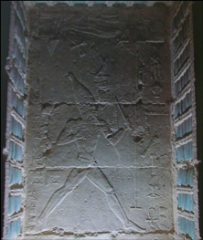
|
Heb Sed Race. Saqqara, South Tomb of Step Pyramids, D3. Ceremony after 30 years of life for King to show his mastery, physical fitness to be King. Repeated every 3 years after that. |
|

|
Maidum Geese, D4, From the tomb of the wife, Atat, of Nefermat (son of Snefru) Exquisitely decorated geese: show details of the feathers, realistic proportions. |
|
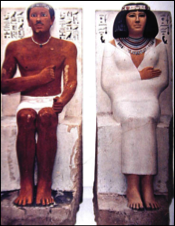
|
Rahotep and Nofret (Snefru), D4, Maidum Vivid colouring, exceptional detail. Gemstone eyes. Men are red-brown and women are yellow. Gender differentiation and more accurate body depiction |
|

|
Bent Pyramid, Snefru, Dashur, D4. Limestone First pyramid with a smooth casing, got the physics wrong. Pyramid collapsed under its own pressure. |
|
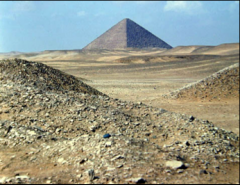
|
Red Pyramid, Snefru, Dashur. D4. Stadelmann excavated and found the pyramid capstone in this pyramid. Was red because of iron oxide. Increased focus on solar orientation 0 east to west instead of north to south that Djoser used. Structure improved from Bent Pyramid. King's burial chamber 30ft off the ground. |
|
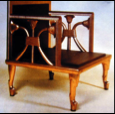
|
Hetep-Heres Furniture. Reproduction in MFA Giza Private Monument, Eastern Cemetery. D4. Found in her mysterious tomb with no body: two beautiful armchairs. Wood rotted, gold foil indicates the shape. Found by photographer in Reisner Camp - G7000x. Mother of Kufu, Snefru's Wife.
|
|
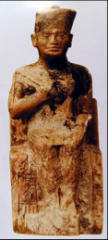
|
King Khufu statue. Abydos Dynasty 4. Ivory. Tiny 3". Only likeness of Khufu found despite him building the Sphinx. Could be practise version. |
|
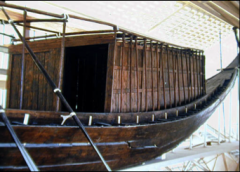
|
Khufu's boat, found next to his boat. Giza, D4. Boat for the afterlife, merging with Sun God. Funerary Boat. Ahmed Yusuf spent years assembling the tiny parts, very well preserved. |
|

|
Hemiunu. Giza Private Tomb D4. Limestone Engineered pyramids of Giza - fat, moobs therefore wealthy and powerful. Shift to elites with more power. Oversaw along with Imhotep. |
|
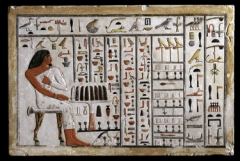
|
Wepemefret Slab Stela. Giza Private Tomb D4. Seals tomb door. Table scene, offerings, carved in raised relief. Huge detail, painted. Key piece of Khufu era burial. |
|
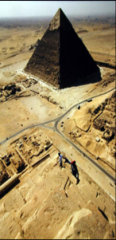
|
Khafre Pyramid D4 Giza, 2nd largest but on higher ground so appears as large as Khufu's. Intact casing stone, no decoration. Smaller pyramid because there are fewer resources. Series of statues around. Nuclear cemeteries around. Causeway leads to Sphinx |
|

|
Khafre Statue. Anothorsite Geniss. Lifesize. Khafre's Valley Temple, D4. Perfect physical specimen. Shows country's prosperity, peak of old kingdom. Horus Falcon behind his head. |
|

|
Bust of Vizier Ankh Haf Giza Private Tombs, Painted Limestone, D4. Egyptian prince and vizier to King Khafre. Son of Snefru. Very accurate and realistic but just a bust. Looks old, tired. Realistic depiction instead of godlike.
|
|
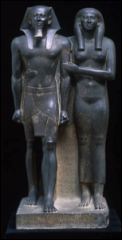
|
Menkaure Dyad Pair Statue. Greywacke. D4. with wife/mother/god? Very well crafted, but unfinished rough base. No inscriptions in base. Classic King stuff: beard, crown, shortened staff. Woman's left foot slightly forward. Red paint still visible. Reisner found it. Cased out Menkaure's pyramid before excavating. |
|
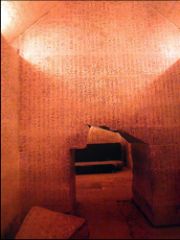
|
Unas Pyramid Texts Saqqara D5 Movement to smaller scale pyramids that are very detailed - high level of craftsmanship. Collection of royal spells gathered to grant successful afterlife. First time burial chamber is decorated. Decentralization - smaller pyramids with more effort in them. |
|
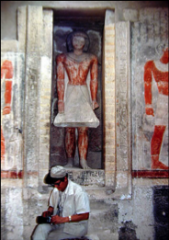
|
Mereuka Niche Saqqara D6. Sculpture of Vizier in largest mastaba in Saqqara. Increased power of officials. Under Teti. Mereuka coming out of niche. Officials have a lot of power, decentralization. |
|
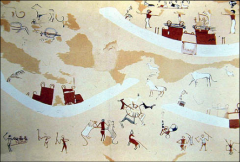
|
Hierakonpolis Painted Tomb 100 - Naqada II First painted tomb. Boats and mastery of animals. Smiting scene, ruler with macehead. Ethos of taming the untameable. Scenes of conflict. Hierakonpolis, predynastic capital. Scenes always showed Egypt conquering. |
|

|
George Reisner and Georg Steindorf One american, one german. Excavated Giza pyramids. 1st Golden Age of Archaelogy. Reisner discovered Hetep Heres and excavated Menkaure tomb. Snuck many items to Harvard. Kept incredibly detailed records, used his own numbering system. |

